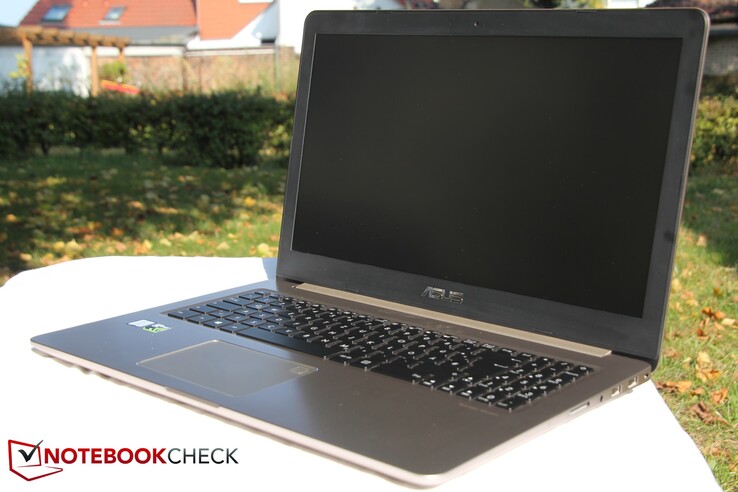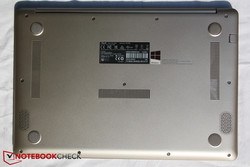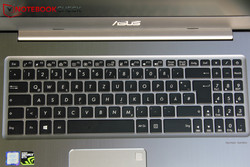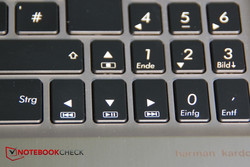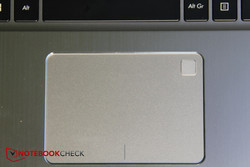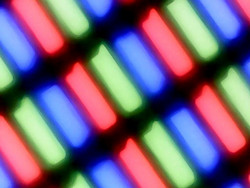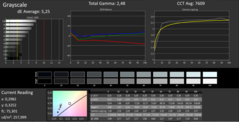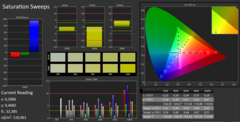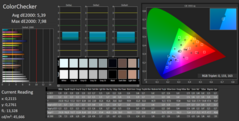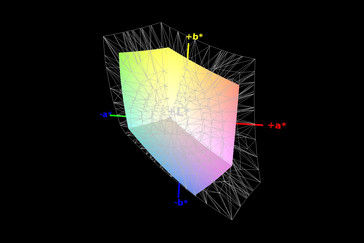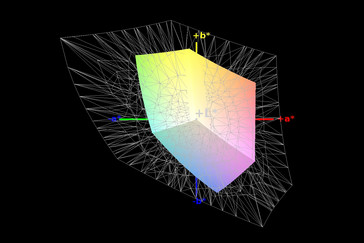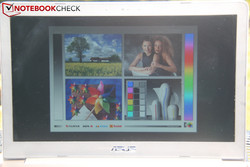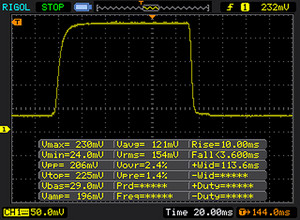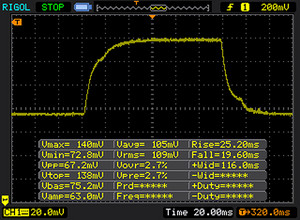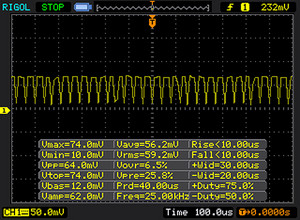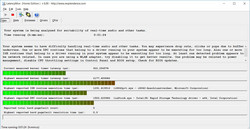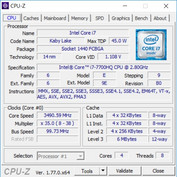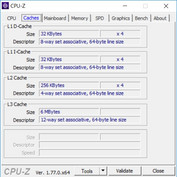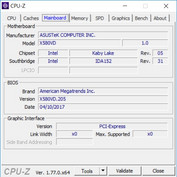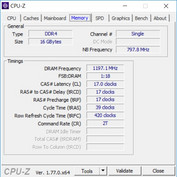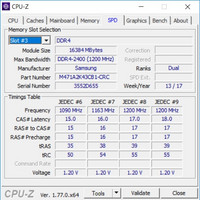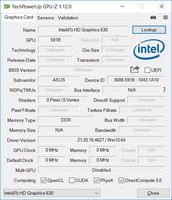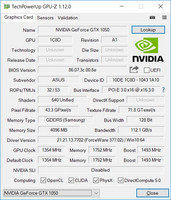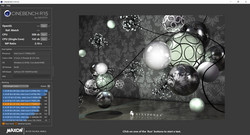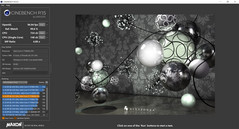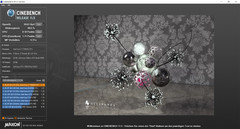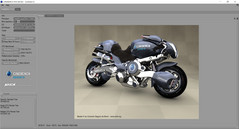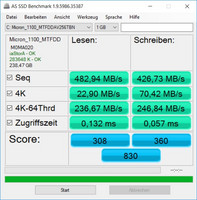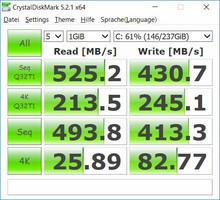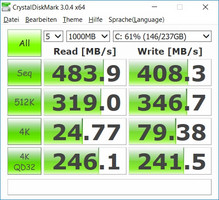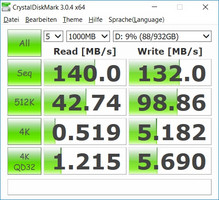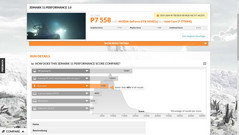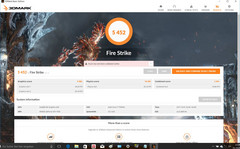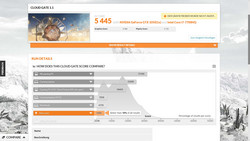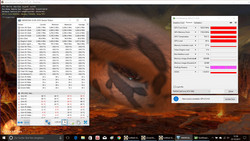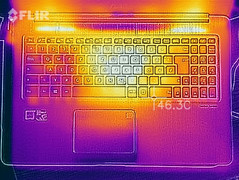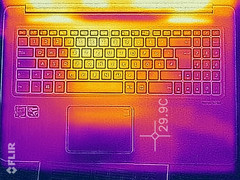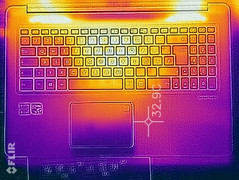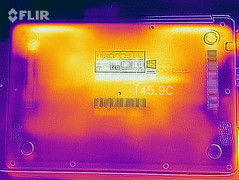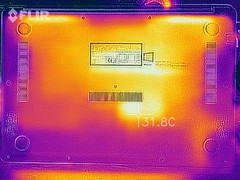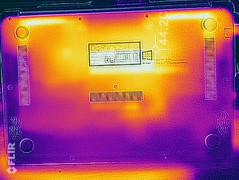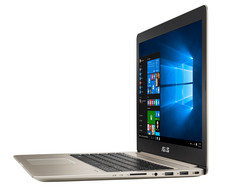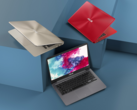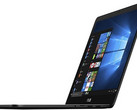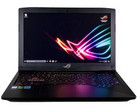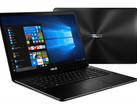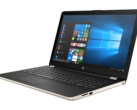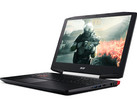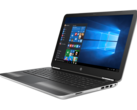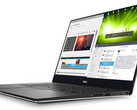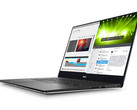Asus VivoBook Pro 15 (i7-7700HQ, GTX 1050) Laptop Review

For the original German review, see here.
The new Asus VivoBook Pro 15 was announced at this year's Computex. It is about 400 Euros ($473) less expensive than its larger sibling Asus ZenBook Pro and is targeting mainstream customers. The starting price for the VivoBook Pro 15 is $1299. We have a look at the differences between the VivoBook and the more expensive ZenBook Pro UX550VD.
It also competes with rivals such as the Gigabyte Sabre 15, the HP Pavilion 15t, the Acer Aspire VX 15, and the Dell XPS 15. However, both the Dell and the Acer have slightly slower processors (Intel Core i5-7300HQ) and only 8 instead of 16 GB of RAM.
You can get the VivoBook Pro with a Full HD or 4K screen. Our test model is equipped with the 1080p panel, Core i7-7700HQ, Nvidia GTX 1050, and 16 GB of RAM. The design of the new VivoBook is now closer to the ZenBook series, so you get a mainstream notebook with premium looks.
Case
The case of the VivoBook Pro 15 has an elegant gold color and is made of brushed aluminum. It is visually closer to the ZenBooks and looks quite sophisticated. The design is otherwise rather simple and typical for a business machine. A silver Asus logo is at the top, but there are no other colored items or gimmicks except for the small indentation at the front, which helps to open the lid.
The base in particular is very sturdy thanks to the aluminum surfaces. There is a lot of resistance when you apply pressure, and there is only some flex in the center of the keyboard as well as some creaking from the left side around the ports. It also looks as if there is a glue pad underneath the right palm rest, because it will stick to the surface beneath for a little while. The lid is very slim and not very torsion resistant due to the construction, but the stability is still sufficient. The inner display bezels are only made of thin plastic.
The only three ventilation slots at are the bottom of the notebook and the openings for the speakers are located at the front. The battery cannot be removed, and there is no maintenance cover. The bottom plate, however, can be removed, but more on that later.
The Dell XPS 15 is the smallest and slimmest device here, but the VivoBook Pro 15 otherwise fares pretty well. It is a bit bigger, but just slightly thicker than the Asus ZenBook. It is also the lightest device at 2 kg (~4.4 lb) next to the Dell and the ZenBook. However, the power adapter adds another 500 grams (~1.1 lb). Both the Acer and the Gigabyte are the largest and heaviest among the rivals.
Connectivity
The port selection is pretty functional and simple. The two USB 2.0 ports in particular are outdated in our opinion. We would have preferred USB 3.x ports only, especially since the only USB-A 3.0 connector on the left side is not marked with a different color. Thunderbolt is missing as well, because you only get a 1.Gen USB-C port. Monitors can be attached via HDMI or USB-C, which supports DisplayPort. There are not many audio ports either, and headphones and microphones share one combo jack. Finally, you also get an SD-card reader as well as Ethernet.
The port layout is okay, thanks to the limited number. The space between the individual ports on the left is not particularly generous, but sufficient. There are no connectors at the front or the rear of the notebook, even the status LEDs are located on the (right) side.
Communication
Our test model performs well in our communication tests, even though there are some mixed results. The transmitting performance of the VivoBook Pro is excellent, but it falls behind many rivals when it receives data. Gigabyte's Sabre is at the bottom of the ranking in both tests.
Security
The notebook is equipped with a fingerprint scanner. It is sitting in the upper right corner of the touchpad and enables quick logins without passwords via Windows Hello.
Accessories
The box of the VivoBook Pro includes only a warranty card, a small service leaflet as well as a special offer for McAfee Live.
Maintenance
There is unfortunately no maintenance hatch on the VivoBook Pro 15 and the battery is integrated as well. This means that it is important to reach the hardware easily. We can see 11 screws at the bottom, but the cover was still sitting tight after the removal of all screws.
We did not want to remove the rubber feet or warranty sticker to look for hidden screws, and it was hard to remove the cover with a sharp object due to minimal gaps. We stopped the attempt to prevent any damages. It is therefore a problem in terms of accessing the internals.
Warranty
The manufacturer offers a two-year Collect & Return warranty in Germany and Austria. Please see our Guarantees, Return Policies & Warranties FAQ for country-specific information.
Input Devices
Keyboard
The keys have a convenient travel, are well labeled, and have sufficient spacing. At least the main keys, because Asus has also implemented a dedicated numeric keypad. This is a good thing in general, but the keys are extremely narrow due to the limited space and feel very cramped as a result. The same applies to the arrow keys, which are also much narrower than usual.
The Power button is integrated into the keyboard in the upper right corner, but you will not confuse it with any special keys since functions such as "End", etc. are secondary functions on the number keypad. Their position is unusual and requires some time to get used to. These functions are only available when the number keypad is deactivated.
The build quality of the keyboard is not particularly impressive in general, but there is not much to criticize either. You can type quickly and the noise level is also okay. However, the keyboard flexes a bit in the center, which can result in a somewhat spongy typing experience.
You also get a three-stage keyboard illumination, which can also be deactivated, but you cannot change the color.
Touchpad
Asus has shifted the touchpad slightly to the left due to the inclusion of the numeric keypad, so the hand is more aligned with the other keys. The size of the pad is sufficient and the smooth surface provides good gliding capabilities. The touchpad obviously supports multi-touch, and it worked well during our review. It is a Precision touchpad and supports gestures with up to four fingers.
The lower part of the pad can be clicked, and there is a stripe that divides the left and right side. The clicking sound, however, is too loud for our taste and sounds pretty cheap.
We have already mentioned the fingerprint scanner in the upper right corner. It can be used to login to Windows via Windows Hello. It uses some space from the touchpad, but this was not a big deal after a little while. It seems that the VivoBook is equipped with the touchpad from the ZenBooks, where we found similar advantages/disadvantages.
Display
Asus has equipped the VivoBook Pro with an Innolux panel from Chi Mei. It looks as if Asus has saved some money here since the panel is not convincing. It is a 1080p panel based on the TN technology; almost all the rivals are using superior IPS models and this is visible in the measurements as well.
This starts with the luminance of the matte panel, which is pretty low at just 224 nits. The brightness distribution of 85% is okay, but could be better. There is at least one rival with an even darker panel, the HP Pavilion, at just 193 nits. We did not notice any backlight bleeding, but this is rare on TN panels anyway.
| |||||||||||||||||||||||||
Brightness Distribution: 85 %
Center on Battery: 246 cd/m²
Contrast: 515:1 (Black: 0.48 cd/m²)
ΔE ColorChecker Calman: 5.39 | ∀{0.5-29.43 Ø4.78}
ΔE Greyscale Calman: 5.25 | ∀{0.09-98 Ø5}
60% sRGB (Argyll 1.6.3 3D)
38% AdobeRGB 1998 (Argyll 1.6.3 3D)
41.27% AdobeRGB 1998 (Argyll 3D)
59.8% sRGB (Argyll 3D)
39.92% Display P3 (Argyll 3D)
Gamma: 2.48
CCT: 7609 K
| Asus VivoBook Pro 15 N580VD-DM028T INNOLUX N156HGA-EAB, , 1920x1080, 15.6" | Asus ZenBook Pro UX550VD CMN15E8 (N156HCE-EN1), , 1920x1080, 15.6" | Gigabyte Sabre 15G ID: LGD0533, Name: LG Display LP156WF6-SPK3, , 1920x1080, 15.6" | HP Pavilion 15t-X7P42AV AU Optronics AUO41ED, , 1920x1080, 15.6" | Acer Aspire VX15 VX5-591G-589S BOE CQ NV156HFM-N42, , 1920x1080, 15.6" | Dell XPS 15 2017 9560 (7300HQ, Full-HD) Sharp SHP1453 LQ156M1, , 1920x1080, 15.6" | |
|---|---|---|---|---|---|---|
| Display | 59% | -2% | -5% | 1% | 70% | |
| Display P3 Coverage (%) | 39.92 | 65.7 65% | 38.97 -2% | 38.03 -5% | 40.56 2% | 68.9 73% |
| sRGB Coverage (%) | 59.8 | 90.3 51% | 58.2 -3% | 56.5 -6% | 59.4 -1% | 98.9 65% |
| AdobeRGB 1998 Coverage (%) | 41.27 | 65.9 60% | 40.3 -2% | 39.29 -5% | 41.9 2% | 70.9 72% |
| Response Times | -49% | -35% | -55% | -84% | -163% | |
| Response Time Grey 50% / Grey 80% * (ms) | 44 ? | 38.8 ? 12% | 32 ? 27% | 44.4 ? -1% | 46 ? -5% | 54 ? -23% |
| Response Time Black / White * (ms) | 13 ? | 27.2 ? -109% | 25.6 ? -97% | 27.2 ? -109% | 34 ? -162% | 52.4 ? -303% |
| PWM Frequency (Hz) | 25000 ? | 25910 ? | 20000 ? | 20000 ? | ||
| Screen | 36% | -18% | -16% | 23% | 46% | |
| Brightness middle (cd/m²) | 247 | 335 36% | 248.4 1% | 209.7 -15% | 277 12% | 400 62% |
| Brightness (cd/m²) | 224 | 313 40% | 241 8% | 193 -14% | 268 20% | 392 75% |
| Brightness Distribution (%) | 85 | 83 -2% | 84 -1% | 75 -12% | 91 7% | 89 5% |
| Black Level * (cd/m²) | 0.48 | 0.27 44% | 0.3 37% | 0.19 60% | 0.26 46% | 0.26 46% |
| Contrast (:1) | 515 | 1241 141% | 828 61% | 1104 114% | 1065 107% | 1538 199% |
| Colorchecker dE 2000 * | 5.39 | 4.7 13% | 7.5 -39% | 7.8 -45% | 5.05 6% | 4.9 9% |
| Colorchecker dE 2000 max. * | 7.98 | 8.1 -2% | 25.2 -216% | 24.1 -202% | 8.93 -12% | 11 -38% |
| Greyscale dE 2000 * | 5.25 | 5.8 -10% | 6.5 -24% | 7.3 -39% | 2.97 43% | 7.2 -37% |
| Gamma | 2.48 89% | 2.06 107% | 2.19 100% | 2.39 92% | 2.39 92% | 2.11 104% |
| CCT | 7609 85% | 6518 100% | 7852 83% | 5771 113% | 6466 101% | 6911 94% |
| Color Space (Percent of AdobeRGB 1998) (%) | 38 | 58.7 54% | 37 -3% | 39.3 3% | 38 0% | 64.2 69% |
| Color Space (Percent of sRGB) (%) | 60 | 90.1 50% | 57.9 -3% | 56.5 -6% | 59 -2% | 98.9 65% |
| Total Average (Program / Settings) | 15% /
30% | -18% /
-17% | -25% /
-19% | -20% /
4% | -16% /
23% |
* ... smaller is better
The contrast is even worse than the luminance. 515:1 is basically just half of what we see from many rivals, and the XPS 13 manages almost three times that. The black value of 0.48 cd/m² is also the worst within the comparison, and the TN panel cannot keep up with the IPS rivals.
Our measurements also determine screen flickering, probably caused by PWM, which is used to control the brightness. However, the flickering occurs only at a luminance of 30% and less. The frequency is also very high at 25 kHz, so even sensitive users should not have a problem.
We are not surprised about the low color gamut. 60% sRGB and 38% AdobeRGB are, however, not surpassed by the rivals either. Both the Asus ZenBook and the Dell in particular perform better in the measurements and especially in terms of color gamut.
Subjectively, we can confirm the impression of the lackluster measurements: The picture quickly appears washed-out depending on the viewing angle (see below), despite the low luminance. The low contrast is also noticeable when you watch a movie. The luminance is at least sufficient for indoor environments.
You need a bright and high-contrast display if you want to use a display outdoors or even under sunlight. The TN-Panel of the VivoBook Pro does not meet these requirements. Still, the values seem to be sufficient to use it at least with indirect lighting. You should look for a place in the shade.
Display Response Times
| ↔ Response Time Black to White | ||
|---|---|---|
| 13 ms ... rise ↗ and fall ↘ combined | ↗ 10 ms rise | |
| ↘ 3 ms fall | ||
| The screen shows good response rates in our tests, but may be too slow for competitive gamers. In comparison, all tested devices range from 0.1 (minimum) to 240 (maximum) ms. » 32 % of all devices are better. This means that the measured response time is better than the average of all tested devices (20.2 ms). | ||
| ↔ Response Time 50% Grey to 80% Grey | ||
| 44 ms ... rise ↗ and fall ↘ combined | ↗ 25 ms rise | |
| ↘ 19 ms fall | ||
| The screen shows slow response rates in our tests and will be unsatisfactory for gamers. In comparison, all tested devices range from 0.165 (minimum) to 636 (maximum) ms. » 73 % of all devices are better. This means that the measured response time is worse than the average of all tested devices (31.6 ms). | ||
Screen Flickering / PWM (Pulse-Width Modulation)
| Screen flickering / PWM detected | 25000 Hz | ≤ 30 % brightness setting | |
The display backlight flickers at 25000 Hz (worst case, e.g., utilizing PWM) Flickering detected at a brightness setting of 30 % and below. There should be no flickering or PWM above this brightness setting. The frequency of 25000 Hz is quite high, so most users sensitive to PWM should not notice any flickering. In comparison: 53 % of all tested devices do not use PWM to dim the display. If PWM was detected, an average of 8108 (minimum: 5 - maximum: 343500) Hz was measured. | |||
The viewing angle stability is usually another drawback of TN panels, and this model is not much different. The loss of details is still okay when you look at it from the side, but vertical shifts are a problem. The content quickly looks very dark and black as soon as you tilt the display back, while it is quickly washed and white out from above. You will have to adjust the opening angle very often.
Performance
The Asus VivoBook Pro 15 is equipped with an Intel Core i7-7700HQ CPU, Nvidia GTX 1050 GPU and 16 GB of RAM. The storage solution consists of a 256 GB SSD in combination with a 1 TB hard drive. The specifications are very similar to the competing multimedia laptops. The hardware suggests a good all-rounder, which should handle almost all the tasks you throw at it. Even gaming is possible, but there are limitations. The VivoBook Pro 15 should therefore be a good choice for occasional gaming, light video and picture editing as well as office applications.
The tool LatencyMon revealed some dropouts, so the notebook can have some issues with real-time audio playback or other applications. The problems might be caused by driver issues.
Processor
The Core i7-7700HQ is an Intel processor based on the Kaby Lake architecture. It is a quad-core with Hyperthreading support, so it can execute up to eight threads simultaneously. It is 200 MHz faster than its Skylake predecessor and now runs with clocks between 2.8 and 3.8 GHz. It is the fourth fastest model in the mobile Kaby Lake range, so it is a fast processor with plenty of performance for all applications.
The clocks are not significantly reduced in our 30-minute loop of Cinebench Multi-core and we can see a steady 3.4 GHz, even though there are some deviations towards the end.
The CPU performance is much lower on battery power. The CPU cores fluctuated between 3.2 GHz and 800 MHz in the Cinebench R15 Multi-core test, while we saw 3.4 to 3.5 GHz in the Single test with short drops. The Multi-core performance result is significantly lower at 281 vs. 700 points on mains. This is not a normal behavior and we only noticed it in this benchmark, so we believe it is an outlier. Further developments did not improve the performance. Maybe there are still some driver issues concerning the optimal core utilization in Multithread scenarios.
All competitors are basically on par in the Cinebench Multi-core test, only the Acer and Dell fall behind by 16 to 30% due to their slower processors. The VivoBook Pro is sitting between these two models in the Single-core test and is about 8% slower than rivals with the same CPU. It seems that our review unit cannot utilize its full Turbo potential, but the results are still within the normal range for a Core i7-7700HQ according to our CPU benchmark list.
| Cinebench R11.5 | |
| CPU Multi 64Bit | |
| Gigabyte Sabre 15G | |
| Asus VivoBook Pro 15 N580VD-DM028T | |
| HP Pavilion 15t-X7P42AV | |
| CPU Single 64Bit | |
| Gigabyte Sabre 15G | |
| HP Pavilion 15t-X7P42AV | |
| Asus VivoBook Pro 15 N580VD-DM028T | |
| Cinebench R10 | |
| Rendering Multiple CPUs 64Bit | |
| Asus VivoBook Pro 15 N580VD-DM028T | |
| Rendering Single CPUs 64Bit | |
| Asus VivoBook Pro 15 N580VD-DM028T | |
System Performance
All the competitors are in the same ballpark in the PCMark 8 Work test, only the HP Pavilion falls behind by 42%, which is hard to understand. Our VivoBook is inconspicuous.
The Home score shows bigger differences. Our test model is ranked third behind the HP and ZenBook (+9 and +10%, respectively). The rivals from Acer, Dell, and Gigabyte are 4 to 10% slower.
We did not experience any issues and office applications in particular are no challenge for the system. Windows 10 always ran smoothly and without noticeable delays.
| PCMark 8 Home Score Accelerated v2 | 3833 points | |
| PCMark 8 Work Score Accelerated v2 | 4934 points | |
Help | ||
Storage Devices
The primary Micron SSD 1100 has a storage capacity of 256 GB and is on place 214 of our SSD/HDD ranking. It is an SSD with average transfer rates connected via SATA-III, so it cannot benefit from the potentially faster NVMe-interface. The Asus ZenBook is equipped with a faster NVMe model, but the VivoBook can keep up with the other rivals.
| Asus VivoBook Pro 15 N580VD-DM028T Micron 1100 MTFDDAV256TBN | Asus ZenBook Pro UX550VD Samsung PM961 NVMe MZVLW512HMJP | HP Pavilion 15t-X7P42AV Samsung CM871a MZNTY128HDHP | Acer Aspire VX15 VX5-591G-589S Hynix HFS128G39TND | Dell XPS 15 2017 9560 (7300HQ, Full-HD) WDC WD10SPCX-75KHST0 + SanDisk Z400s M.2 2242 32 GB Cache | |
|---|---|---|---|---|---|
| CrystalDiskMark 3.0 | 142% | 9% | -3% | -80% | |
| Read Seq (MB/s) | 483.9 | 1434 196% | 522 8% | 510 5% | 123 -75% |
| Write Seq (MB/s) | 408.3 | 1365 234% | 476.6 17% | 137.6 -66% | 74.2 -82% |
| Read 512 (MB/s) | 319 | 614 92% | 399.7 25% | 362.1 14% | 101.7 -68% |
| Write 512 (MB/s) | 346.7 | 688 98% | 185.4 -47% | 137.2 -60% | 42.51 -88% |
| Read 4k (MB/s) | 24.77 | 60.6 145% | 33.12 34% | 35.18 42% | 10.84 -56% |
| Write 4k (MB/s) | 79.4 | 158 99% | 89.8 13% | 104.8 32% | 1.021 -99% |
| Read 4k QD32 (MB/s) | 246.1 | 617 151% | 400.9 63% | 375.8 53% | 69.8 -72% |
| Write 4k QD32 (MB/s) | 241.5 | 525 117% | 140.2 -42% | 138.1 -43% | 1.057 -100% |
GPU Performance
The VivoBook Pro 15 can use two graphics adapters: The integrated processor GPU Intel HD Graphics 630 and the dedicated Nvidia GTX 1050 with 4 GB of VRAM. The iGPU takes care of simple tasks such as office applications, while the dGPU is active for more challenging tasks such as video editing or gaming. Nvidia's Optimus technology is supported, so the system chooses the GPU automatically and saves power during light workloads, but provides sufficient performance for other tasks.
Nvidia's GTX 1050 is an entry-level Pascal GPU with mainstream performance figures, so it is a real all-rounder. Modern games should be playable at medium settings, but the performance also depends a lot on the cooling system. We check whether the card can utilize its full performance potential or not.
All models are very close together in the synthetic 3DMark 11 and 2013 tests, only the Dell is between 4 and 7% faster depending on the test. Otherwise, there are no outliers and the VivoBook is on the expected performance level.
The performance is throttled significantly on battery power. 3DMark 13 is one example, especially the Cloud Gate benchmark. While the VivoBook still managed about 38000 points (Graphics) on mains, the result dropped to just 6900 points on battery. This is a deficit of more than 80% – a negative record. 3DMark 11 even refused to run; the High-Performance profile was active in both cases.
| 3DMark | |
| 1280x720 Cloud Gate Standard Graphics | |
| Dell XPS 15 2017 9560 (7300HQ, Full-HD) | |
| Gigabyte Sabre 15G | |
| HP Pavilion 15t-X7P42AV | |
| Asus VivoBook Pro 15 N580VD-DM028T | |
| Asus ZenBook Pro UX550VD | |
| 1920x1080 Fire Strike Graphics | |
| Dell XPS 15 2017 9560 (7300HQ, Full-HD) | |
| Gigabyte Sabre 15G | |
| HP Pavilion 15t-X7P42AV | |
| Asus ZenBook Pro UX550VD | |
| Asus VivoBook Pro 15 N580VD-DM028T | |
| 3DMark 11 Performance | 7558 points | |
| 3DMark Cloud Gate Standard Score | 20059 points | |
| 3DMark Fire Strike Score | 5452 points | |
Help | ||
Gaming Performance
Modern games can usually be played smoothly at medium settings with the GTX 1050, which is supported by our gaming benchmarks. The VivoBook Pro manages 31 FPS (on average) in the “Witcher 3” at 1080p and high details, but the gaming experience was not smooth at all. You should therefore reduce either the resolution or the settings. Medium details in 1366x768 pixels resulted in 69 FPS, so there is still headroom for more challenging scenes, even higher details are still possible.
We can see a steady frame rate when the power adapter is attached. Our graph below shows there is no throttling.
This changes on battery power: As with our previous tests, the performance is heavily throttled on battery. We expect the “Witcher 3” will be unplayable in this state, so we tested it with the medium preset, where we determined 69 FPS on mains. This value drops to just 24 FPS on battery (-65%). There is significant stuttering and the game is basically unplayable – at medium settings! It is curious that the fans are almost inaudible, despite the gaming load, which is another indicator of an unbalanced fan control.
The VivoBook is slightly behind the rivals, but the deviations are pretty big. The rivals are often up to 10% faster (depending on the setting) in the “Witcher 3”, especially the Dell is much faster in Full HD and high settings (up to 30%), and the VivoBook is usually at the bottom of the ranking, but all the rivals are back on par in the ultra preset.
You can still play almost every game at medium settings, despite the small drawback. However, this is only the case on mains. Medium settings on battery power are usually not very smooth.
| The Witcher 3 | |
| 1024x768 Low Graphics & Postprocessing (sort by value) | |
| Asus VivoBook Pro 15 N580VD-DM028T | |
| HP Pavilion 15t-X7P42AV | |
| Dell XPS 15 2017 9560 (7300HQ, Full-HD) | |
| 1366x768 Medium Graphics & Postprocessing (sort by value) | |
| Asus VivoBook Pro 15 N580VD-DM028T | |
| Asus ZenBook Pro UX550VD | |
| HP Pavilion 15t-X7P42AV | |
| Dell XPS 15 2017 9560 (7300HQ, Full-HD) | |
| 1920x1080 High Graphics & Postprocessing (Nvidia HairWorks Off) (sort by value) | |
| Asus VivoBook Pro 15 N580VD-DM028T | |
| Asus ZenBook Pro UX550VD | |
| Gigabyte Sabre 15G | |
| HP Pavilion 15t-X7P42AV | |
| Dell XPS 15 2017 9560 (7300HQ, Full-HD) | |
| low | med. | high | ultra | |
|---|---|---|---|---|
| The Witcher 3 (2015) | 111.4 | 69.8 | 31.02 | 20 |
| Rise of the Tomb Raider (2016) | 124.2 | 69.3 | 39.12 | 31.59 |
Emissions
System Noise
The fan behavior reveals unnecessary weaknesses. The noise levels of the VivoBook Pro 15 are actually inconspicuous and average within our comparison group, but the fans are never deactivated while idling. The ZenBook is quieter in general, which is also the case under load. Acer's Aspire is quieter too, but the other rivals are a bit louder.
However, the fans are very annoying in practice. We can notice a frequent pulsating of the fans for a few minutes, without any apparent reason. It already starts after the system is running for a little while, even though the device is still cold and we are performing usual office applications. The frequent pulsating can only be prevented by switching into Power-Saver mode. It seems that Asus can still improve the fan control, because the pulsating is completely unnecessary. The notebook is therefore often loud, which is particularly annoying in quiet environments. We did not notice any other annoying electronic sound or the like. We hope Asus will improve this behavior via firmware update.
| Asus VivoBook Pro 15 N580VD-DM028T GeForce GTX 1050 Mobile, i7-7700HQ, Micron 1100 MTFDDAV256TBN | Asus ZenBook Pro UX550VD GeForce GTX 1050 Mobile, i7-7700HQ, Samsung PM961 NVMe MZVLW512HMJP | Gigabyte Sabre 15G GeForce GTX 1050 Mobile, i7-7700HQ, Liteonit CV3-8D128 | HP Pavilion 15t-X7P42AV GeForce GTX 1050 Mobile, i7-7700HQ, Samsung CM871a MZNTY128HDHP | Acer Aspire VX15 VX5-591G-589S GeForce GTX 1050 Mobile, i5-7300HQ, Hynix HFS128G39TND | Dell XPS 15 2017 9560 (7300HQ, Full-HD) GeForce GTX 1050 Mobile, i5-7300HQ, WDC WD10SPCX-75KHST0 + SanDisk Z400s M.2 2242 32 GB Cache | |
|---|---|---|---|---|---|---|
| Noise | 7% | -7% | -5% | 7% | -6% | |
| off / environment * (dB) | 30.5 | 29.4 4% | 28.2 8% | 29.3 4% | 30 2% | 30.3 1% |
| Idle Minimum * (dB) | 30.6 | 29.4 4% | 33 -8% | 32.3 -6% | 30 2% | 31.6 -3% |
| Idle Average * (dB) | 30.9 | 29.9 3% | 33.3 -8% | 32.3 -5% | 30 3% | 31.6 -2% |
| Idle Maximum * (dB) | 31.9 | 29.9 6% | 34.7 -9% | 32.4 -2% | 31.1 3% | 33.4 -5% |
| Load Average * (dB) | 38.6 | 38.3 1% | 44.5 -15% | 44.4 -15% | 31.3 19% | 47.8 -24% |
| Witcher 3 ultra * (dB) | 47.3 | 39.8 16% | 49.2 -4% | |||
| Load Maximum * (dB) | 45.7 | 39.6 13% | 52.8 -16% | 49.2 -8% | 38.9 15% | 47.8 -5% |
* ... smaller is better
Noise level
| Idle |
| 30.6 / 30.9 / 31.9 dB(A) |
| HDD |
| 30.9 dB(A) |
| Load |
| 38.6 / 45.7 dB(A) |
 | ||
30 dB silent 40 dB(A) audible 50 dB(A) loud |
||
min: | ||
Temperature
The situation for the VivoBook is better in the temperature section, and it is even slightly better than the ZenBook. Only the HP Pavilion is cooler here, but our test model is still on the second place and does not get as warm as most competitors.
The temperature development is also good: Almost the whole area around the palm rests is conveniently cool. The center of the keyboard can warm up quite a bit under load and the temperature at the bottom can be uncomfortable as well. Using the VivoBook on your lap is no problem except for extreme load scenarios.
We can see a slightly reduced CPU clock in our stress test with the tools Prime95 and FurMark after ~15 minutes, when the clock levels off at around 3.3 GHz and a core temperature of around 90 °C (~194 °F). The graphics card warms up to "only" 79 °C (~174 °F), so it can utilize its performance steadily.
(±) The maximum temperature on the upper side is 41.8 °C / 107 F, compared to the average of 36.9 °C / 98 F, ranging from 21.1 to 71 °C for the class Multimedia.
(+) The bottom heats up to a maximum of 36.8 °C / 98 F, compared to the average of 39.2 °C / 103 F
(+) In idle usage, the average temperature for the upper side is 25.2 °C / 77 F, compared to the device average of 31.3 °C / 88 F.
(-) Playing The Witcher 3, the average temperature for the upper side is 38.8 °C / 102 F, compared to the device average of 31.3 °C / 88 F.
(+) The palmrests and touchpad are reaching skin temperature as a maximum (34.8 °C / 94.6 F) and are therefore not hot.
(-) The average temperature of the palmrest area of similar devices was 28.7 °C / 83.7 F (-6.1 °C / -10.9 F).
| Asus VivoBook Pro 15 N580VD-DM028T GeForce GTX 1050 Mobile, i7-7700HQ, Micron 1100 MTFDDAV256TBN | Asus ZenBook Pro UX550VD GeForce GTX 1050 Mobile, i7-7700HQ, Samsung PM961 NVMe MZVLW512HMJP | Gigabyte Sabre 15G GeForce GTX 1050 Mobile, i7-7700HQ, Liteonit CV3-8D128 | HP Pavilion 15t-X7P42AV GeForce GTX 1050 Mobile, i7-7700HQ, Samsung CM871a MZNTY128HDHP | Acer Aspire VX15 VX5-591G-589S GeForce GTX 1050 Mobile, i5-7300HQ, Hynix HFS128G39TND | Dell XPS 15 2017 9560 (7300HQ, Full-HD) GeForce GTX 1050 Mobile, i5-7300HQ, WDC WD10SPCX-75KHST0 + SanDisk Z400s M.2 2242 32 GB Cache | |
|---|---|---|---|---|---|---|
| Heat | -9% | -8% | 6% | -16% | -14% | |
| Maximum Upper Side * (°C) | 41.8 | 43.6 -4% | 43.6 -4% | 41.8 -0% | 47.2 -13% | 47.6 -14% |
| Maximum Bottom * (°C) | 36.8 | 44.5 -21% | 40.2 -9% | 33.4 9% | 42.2 -15% | 42.1 -14% |
| Idle Upper Side * (°C) | 26.2 | 28 -7% | 27.8 -6% | 24.4 7% | 31.8 -21% | 29.9 -14% |
| Idle Bottom * (°C) | 25.9 | 26.7 -3% | 29.2 -13% | 23.8 8% | 29.5 -14% | 29.8 -15% |
* ... smaller is better
Speakers
Asus advertises a premium sound experience from powerful speakers co-developed by Harman Kardon. It is supposed to be up to 320% louder than standard laptops – including intense bass and obviously much better sound in general. The maximum volume is really a bit higher than comparable devices, but you should still not expect a wide sound spectrum or very good bass reproduction, even though the latter is still surprisingly good for this class of devices. Many other systems have problems delivering any bass at all, so the VivoBook definitely has the edge here.
Headphones and other external devices can only be attached via the combined stereo jack.
Asus VivoBook Pro 15 N580VD-DM028T audio analysis
(-) | not very loud speakers (71.6 dB)
Bass 100 - 315 Hz
(±) | reduced bass - on average 10.1% lower than median
(±) | linearity of bass is average (11.8% delta to prev. frequency)
Mids 400 - 2000 Hz
(+) | balanced mids - only 1.6% away from median
(+) | mids are linear (4.9% delta to prev. frequency)
Highs 2 - 16 kHz
(+) | balanced highs - only 1.3% away from median
(+) | highs are linear (3% delta to prev. frequency)
Overall 100 - 16.000 Hz
(+) | overall sound is linear (9.3% difference to median)
Compared to same class
» 11% of all tested devices in this class were better, 1% similar, 89% worse
» The best had a delta of 5%, average was 17%, worst was 45%
Compared to all devices tested
» 3% of all tested devices were better, 1% similar, 96% worse
» The best had a delta of 4%, average was 24%, worst was 134%
Apple MacBook 12 (Early 2016) 1.1 GHz audio analysis
(+) | speakers can play relatively loud (83.6 dB)
Bass 100 - 315 Hz
(±) | reduced bass - on average 11.3% lower than median
(±) | linearity of bass is average (14.2% delta to prev. frequency)
Mids 400 - 2000 Hz
(+) | balanced mids - only 2.4% away from median
(+) | mids are linear (5.5% delta to prev. frequency)
Highs 2 - 16 kHz
(+) | balanced highs - only 2% away from median
(+) | highs are linear (4.5% delta to prev. frequency)
Overall 100 - 16.000 Hz
(+) | overall sound is linear (10.2% difference to median)
Compared to same class
» 7% of all tested devices in this class were better, 2% similar, 91% worse
» The best had a delta of 5%, average was 18%, worst was 53%
Compared to all devices tested
» 4% of all tested devices were better, 1% similar, 94% worse
» The best had a delta of 4%, average was 24%, worst was 134%
Frequency Comparison (Checkboxes select/deselectable!)
Energy Management
Power Consumption
The VivoBook Pro is the most efficient notebook while idling in a direct comparison. The consumption is decent in general, even though the load values are higher compared to some of the rivals. All in all, the test model is still comparatively efficient, especially in practical office scenarios.
The maximum consumption in our stress test is 120 W, so the provided 120 W power adapter is working at its limit. We still measure 109 W in the “Witcher 3” (Ultra), so the power adapter should be sufficient in practice.
| Off / Standby | |
| Idle | |
| Load |
|
Key:
min: | |
| Asus VivoBook Pro 15 N580VD-DM028T i7-7700HQ, GeForce GTX 1050 Mobile, Micron 1100 MTFDDAV256TBN, TN, 1920x1080, 15.6" | Asus ZenBook Pro UX550VD i7-7700HQ, GeForce GTX 1050 Mobile, Samsung PM961 NVMe MZVLW512HMJP, IPS, 1920x1080, 15.6" | Gigabyte Sabre 15G i7-7700HQ, GeForce GTX 1050 Mobile, Liteonit CV3-8D128, IPS, 1920x1080, 15.6" | HP Pavilion 15t-X7P42AV i7-7700HQ, GeForce GTX 1050 Mobile, Samsung CM871a MZNTY128HDHP, IPS, 1920x1080, 15.6" | Acer Aspire VX15 VX5-591G-589S i5-7300HQ, GeForce GTX 1050 Mobile, Hynix HFS128G39TND, IPS, 1920x1080, 15.6" | Dell XPS 15 2017 9560 (7300HQ, Full-HD) i5-7300HQ, GeForce GTX 1050 Mobile, WDC WD10SPCX-75KHST0 + SanDisk Z400s M.2 2242 32 GB Cache, LED IGZO IPS InfinityEdge, 1920x1080, 15.6" | |
|---|---|---|---|---|---|---|
| Power Consumption | -2% | -14% | -19% | -27% | -12% | |
| Idle Minimum * (Watt) | 4.7 | 5.05 -7% | 8 -70% | 8.29 -76% | 8.4 -79% | 6.6 -40% |
| Idle Average * (Watt) | 7.7 | 8.2 -6% | 10.9 -42% | 8.9 -16% | 13.1 -70% | 9 -17% |
| Idle Maximum * (Watt) | 10.9 | 12.2 -12% | 11 -1% | 10.2 6% | 14.2 -30% | 10.7 2% |
| Load Average * (Watt) | 82 | 82 -0% | 76.7 6% | 77.1 6% | 50 39% | 77.5 5% |
| Witcher 3 ultra * (Watt) | 109 | 93.1 15% | 94.9 13% | |||
| Load Maximum * (Watt) | 120 | 120 -0% | 106.4 11% | 136.6 -14% | 111 7% | 130 -8% |
* ... smaller is better
Battery Runtime
The battery capacity of our test model is 47 Wh, which does not appear to be much. We check how long the VivoBook will last in different scenarios.
We determine the maximum runtime with the Battery Eater Reader's Test and active Power-Saver profile, deactivated wireless modules, and the minimum luminance. The VivoBook lasts little more than 10 hours. A decent result, but both the ZenBook as well as the HP are even more enduring.
The opposite is the minimum runtime with active wireless modules, High-Performance profile, and maximum luminance. The Battery Eater Classic Test simulates a load scenario. The battery of the VivoBook lasts 82 minutes, so the VivoBook can beat the more expensive ZenBook.
Our practical test simulates continuous web browsing at an adjusted luminance and the Balanced power profile. We determine around six and a half hours. HP and ZenBook are once again better, but the other devices are beaten.
Our video loop runs at a luminance of 150 nits with the Power-Saver profile and deactivated wireless modules. The sample video runs for almost six hours. The ZenBook lasts almost two hours longer, which is a good result.
All in all, the runtime is decent and the VivoBook Pro is average within the comparison group. The device supports Quick Charge and charges the battery to ~60% within one hour. A full recharge takes about two hours.
| Asus VivoBook Pro 15 N580VD-DM028T i7-7700HQ, GeForce GTX 1050 Mobile, 47 Wh | Asus ZenBook Pro UX550VD i7-7700HQ, GeForce GTX 1050 Mobile, 73 Wh | Gigabyte Sabre 15G i7-7700HQ, GeForce GTX 1050 Mobile, 47 Wh | HP Pavilion 15t-X7P42AV i7-7700HQ, GeForce GTX 1050 Mobile, 63.3 Wh | Acer Aspire VX15 VX5-591G-589S i5-7300HQ, GeForce GTX 1050 Mobile, 52.5 Wh | Dell XPS 15 2017 9560 (7300HQ, Full-HD) i5-7300HQ, GeForce GTX 1050 Mobile, 56 Wh | |
|---|---|---|---|---|---|---|
| Battery runtime | 32% | -20% | 31% | -15% | -7% | |
| Reader / Idle (h) | 10.2 | 17.7 74% | 8.2 -20% | 16 57% | 9.4 -8% | |
| H.264 (h) | 5.9 | 7.8 32% | ||||
| WiFi v1.3 (h) | 6.5 | 8.9 37% | 4.4 -32% | 6.5 0% | 5.5 -15% | 5.6 -14% |
| Load (h) | 1.4 | 1.2 -14% | 1.3 -7% | 1.9 36% | 1.4 0% | |
| Witcher 3 ultra (h) | 1.1 |
Pros
Cons
Verdict
The Asus VivoBook Pro 15 has an elegant chassis and convinces with efficient operation while idling, a convenient weight, good speakers, and good temperature development.
We are still having trouble recommending the VivoBook at this point, because there are dropouts, extreme throttling on battery power and pulsating fan behavior. All of these problems should be fixable by software updates. However, the display also falls behind the rivals and the port selection is meager. It is still one of the most expensive device here.
Currently, the negative aspects define the general impression. It is not necessarily an issue of the device, but looks more like a firmware problem. Asus should quickly fix these issues, so the VivoBook can be a good laptop. We also think the price is currently too high, and some of the rivals are less expensive.
The Asus VivoBook Pro 15 is still fighting some bugs such as dropouts/latencies, severe throttling on battery power, and poor fan controls. You also get a comparatively bad TN panel, so the price is currently not justified.
Asus VivoBook Pro 15 N580VD-DM028T
- 10/09/2017 v6 (old)
Christian Hintze




